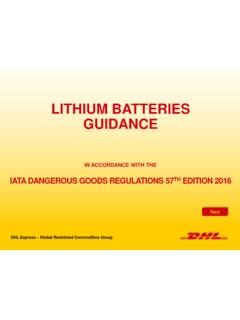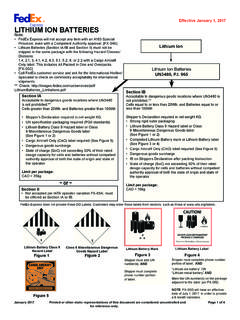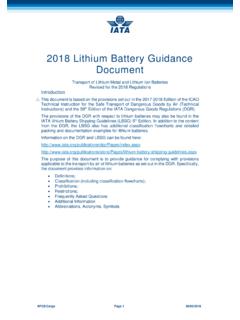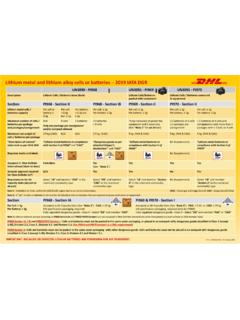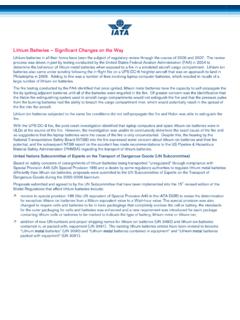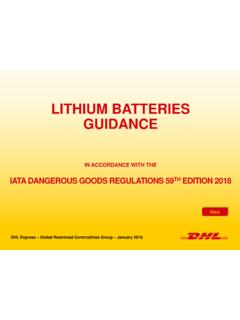Transcription of Transportation Regulation FAQs for Lithium and Lithium Ion ...
1 COPYRIGHT 2011 ENERGY ASSURANCE, ALL RIGHTS RESERVED Transportation Regulation faqs for Lithium and Lithium Ion cells and batteries This document is intended to provide some general guidance to questions we frequently receive related to shipment of Lithium and Lithium Ion cells and batteries , as well as products being shipped with batteries and cells , or containing batteries and cells . For more detailed information about your specific situation, please contact us. What are the regulations that govern the transport of Lithium and Lithium Ion cells and batteries ? The governing organization for the transport of Lithium and Lithium Ion cells and batteries ( cells and batteries ) varies based on the shipping method and region(s).
2 Air transport (domestic and international) Shipments of cells and batteries by air are governed by the International Civil Aviation Organization (ICAO) and the International Air Transport Association (IATA). ICAO has Technical Instruction for the shipment of Dangerous Goods, and IATA has a corresponding Dangerous Goods regulations . Sea transport Shipments by sea are regulated by the International Maritime Dangerous Goods (IMDG), which parallel the air transport regulations . Transportation within the US (vehicle, air and vessel) Shipments within the United States are additionally regulated by the US Department of Transportation through the Code of Federal regulations , CFR 49 (Sections 100-185), through the Hazardous Materials regulations (HMR).
3 Transportation within other countries Other countries, such as China, have specific regulations for the shipment of Lithium and Lithium Ion cells and batteries and should be investigated individually. What are the current Transportation regulations in the Transport of cells and batteries within the is regulated through 49 CFR Sections 100-185 of the Hazardous Materials regulations (HMR). Specifically, Section and the special provisions in Section apply to Lithium and Lithium Ion cells and batteries . These sections include information on packaging for shipping, package weight limits, required testing, and exceptions that COPYRIGHT 2011 ENERGY ASSURANCE, ALL RIGHTS RESERVED may apply.
4 The regulations are based on the mass of Lithium in the anode of Lithium cell and battery, and based on equivalent Lithium content for Lithium Ion cells and batteries . The table below outlines the shipping regulations currently in effect for the Primary cells and batteries Lithium Content Limits (Cell/Battery) Secondary Lithium Ion cells and batteries Equivalent Lithium1 Content Limits (Cell/Battery) Battery Size2 Shipping Classification Special Packaging/Markings Required g/ g grams/ grams Small Excepted Yes3 Between 1g and 5g/ Between 2g and 25g Between and 5g/ Between 8g and 25g Medium Class 94 Yes4 > g/> g > g/ > g Large Class 9 Yes5 Notes: 1 Equivalent Lithium Content (ELC) = x rated capacity (Ah) x # of cells (for packs) 2 The sizes noted here are based solely on DoT definitions in 49 CFR.
5 These are not the same as ICAO/IATA size definitions, or UN Manual of Tests size definitions. 3. Packages containing more than 12 batteries or 24 cells must meet certain packaging, marking and shipping paper requirements. 4 Must be shipped as Class 9 hazardous materials unless transported by motor vehicle or rail. 5 Requires Class 9 markings, label, specified packaging and appropriate shipping papers. All of these regulations apply not only to cells and batteries alone, but to end product shipped with these types of cells and batteries , as well as end products containing these types of cells and batteries . Another important note is that, with a very limited set of exceptions, no Lithium or Lithium Ion cells or batteries may be introduced for transport in any mode without first completing testing in accordance with the UN Manual of Test and Criteria.
6 Exceptions to this include shipping of prototypes for testing and waste batteries . HMR website. What are the current transport regulations internationally? ICAO Technical Instructions, IATA Dangerous Goods regulations and the IMDG Code are the regulations in place to cover international shipments of Lithium and Lithium Ion cells and batteries . All of these codes require cells and batteries of these types to be tested to show compliance with the UN Manual of Tests and Criteria. Additionally, as with the regulations , the rules apply to cells and batteries shipped alone as well as those shipped with equipment, or contained in equipment as noted by the UN shipping numbers and names for the products as noted in the following table.
7 COPYRIGHT 2011 ENERGY ASSURANCE, ALL RIGHTS RESERVED UN Shipping Name UN Number Lithium ion batteries UN 3480 Lithium ion batteries packed with equipment UN 3481 Lithium ion batteries contained in equipment UN 3481 Lithium metal batteries UN 3090 Lithium metal batteries packed with equipment UN 3091 Lithium metal batteries contained in equipment UN 3091 These international regulations use only 2 size classifications which are based on Lithium content for Lithium batteries and Watt-hour rating for Lithium Ion batteries . The table below outlines the shipping regulations currently in effect based on these international regulations . Primary cells and batteries Lithium Content Limits (Cell/Battery) Secondary Lithium Ion cells and batteries Watt-hour1 Limits (Cell/Battery) Shipping Classification Special Packaging/Markings / 20Wh / 100Wh Excepted Yes > / > >20Wh / >100Wh Class 9 Yes Notes: 1 Watt-hours = rated capacity (Ah) X nominal operating voltage (V).
8 What is meant by Excepted in the tables on current and international regulations ? In both of the above cases, the term excepted means that batteries and cells meeting these criteria AND which have passed testing in accordance with the UN Manual of Tests and Criteria, may be shipped without the Class 9 classification. There are still marking, labeling and shipping document requirements that must be met in order to comply with the exceptions. COPYRIGHT 2011 ENERGY ASSURANCE, ALL RIGHTS RESERVED Can Lithium ( metal ) primary cells and batteries be shipped as cargo on passenger aircraft? No, the US DoT prohibits the offering for Transportation and Transportation of primary Lithium ( metal ) cells and batteries as cargo aboard passenger aircraft, into, out of, and within the United States.
9 The exception to this rule is for primary Lithium cells with no more than 1g of Lithium content and batteries with no more than 2g of Lithium content when they are packed with or installed in equipment only. Even in these cases, the net weight of the cells and batteries in each package cannot exceed 5kg, and the package cannot contain more than the number of cells or batteries necessary to power the piece of equipment. I make medium cells and/or batteries (according to the US DOT definition) and I need to ship only in the , what are my options? As we mentioned in the table above for transport regulations , medium batteries must ship as Class 9 Hazardous Materials. There is a special provision (Special Provision 189) within the HMR that allows for shipments of medium size cells and batteries by motor vehicle or rail car without being classified as Class 9.
10 This provision applies if the following items are met: 1. The cells or batteries are medium based on the HMR criteria. 2. The cells and batteries have been tested in accordance with the UN Manual of Tests and Criteria. 3. cells and batteries are prevented from short circuits and are packed in a strong outer packaging or are contained in equipment. 4. The outside of the package is marked Lithium batteries FORBIDDEN FOR TRANSPORT ABOARD ARICRAFT AND VESSEL on a background of contrasting color, in specific size lettering based on the weight of the package. 5. Each package with more than 12 medium batteries , or 24 medium cells , except when contained in equipment, must comply with appropriate marking, packaging, and documentation requirements.
